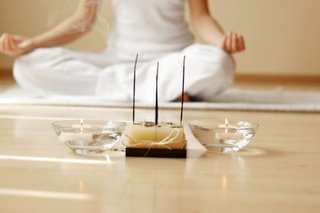
Meditation
I recently stumbled across a powerful meditation technique that uses a three-dimensional mandala as the point of departure for an amazing visualization exercise. As you read it over, I invite you to guess the time and place this technique comes from:
- Imagine the entire universe. Hold it as clearly and distinctly in your mind as you possibly can. See the whole cosmos as if it’s inside an unimaginably vast transparent sphere.
- Visualize our sun and the stars in our sky. Then picture all the living beings on the earth or in the sea. Observe them calmly.
- Call to mind the limitlessly vast Supreme Intelligence who created this universe. Ask it to enter your awareness, bringing with it all the divine forces that exist inside it. Notice that the Supreme Being and all its divine energies and all the creatures and objects and worlds it has created exist together in seamless unity. Imagine the Supreme Being’s unlimited power and awareness extending to all infinity.
- Now bring this vision inside yourself, as if you are that all-pervading Supreme Intelligence. Hold the entire cosmos and all its powers and all its creatures inside your own all-pervading awareness.
- Then let go of the visual images you’ve been imagining. Simply let all the scenes you’ve been visualizing dissolve completely. Instead, focus only on the living reality of the all-pervading Cosmic Intelligence who is silently present.
- Don’t allow any sense of separateness to enter your awareness. Just immerse yourself totally in the divine presence.
- Surrender yourself completely to the Supreme Being who, at this very moment, is holding you in its perfect, unitary awareness. The Supreme Intelligence is totally present in this moment, and there is no distinction whatever between it and you.
- Mentally saluting the Supreme Being, shift your awareness back to your physical body in this physical room in this physical universe, and open your eyes.
This exercise carries your awareness from a concrete image into a higher state of consciousness that is beyond images altogether. It seeks to unite your individual awareness with the cosmic consciousness which holds the whole universe in its awareness the way you hold mental images in yours. Any guesses where it comes from?
Here’s the surprising answer: This meditation was practiced in the city of Rome in the 3rd century AD. It is almost certainly the technique taught to Caesar Gallienus, who ruled the Roman Empire from 253 to 268 AD, and his wife Cornelia. How do I know that? Because it comes from the Enneads, a book written by one of the most famous spiritual masters of the Roman world. His name was Plotinus, and he was the teacher of the emperor and empress as well as numerous prominent members of the Roman Senate. Plotinus concluded the exercise with this advice for the meditator: “If you imagine you’re different from the all-pervading Divine Being, you are not yet in the fully illumined state. When you and it are perfectly one, with no sense of even the possibility that you could be two, then you have attained real understanding and a true perception of your highest self, the true inner being which never departs from complete perfection.”

Did the ancient Greeks and Romans—the founders of Western civilization—practice yoga?
Did the ancient Greeks and Romans—the founders of Western civilization—practice yoga? The astonishing answer is that they certainly practiced something very like it. In southern Europe 2,000 years ago, the deepest state of meditation (samadhi in Sanskrit) was called henosis. Heno is the Greek word for “one”; henosis literally meant “one-pointed awareness” or “unitary consciousness.” There were many centers where you could go to learn how to stabilize your mind in henosis—in the Platonic Academy in Athens, for example, or at the great university in Alexandria, Egypt, or in the schools of extraordinary masters like Plotinus in Rome.
The Oracle at Delphi—the spiritual center of the ancient Greek world—is famous for its simple advice: “Know thyself.” Spiritual teachers like Plotinus took this suggestion to heart. He urged his disciples to “close your eyes and awaken to another way of seeing. This is a skill everyone possesses but few choose to use.” Plotinus died in the year 270. His final words were: “Try to unite the divinity in yourself with the divine in all things.”
Meditation goes back a long way in the Graeco-Roman world. Empedocles, one of the most popular of the Greek sages, was born in Sicily at the beginning of the 5th century BC, 700 years before Plotinus was born. Here’s what Empedocles had to say about the journey within:
You must plunge beneath your crowded thoughts and calmly contemplate the higher realities with pure, focused attention. If you do this, a state of inspired serenity will remain with you throughout your life, shaping your character and benefiting you in so many ways. But if you direct your attention instead to the trivial things most people obsess about, the silly nonsense that dulls their minds, you’ll just acquire more objects which you’ll only lose anyway.
Like many of the ancient Greek masters, Empedocles also spoke of reincarnation when he said, “The wise never imagine that man lives only for one lifetime, that before and afterwards he doesn’t exist at all. Souls, who through their own error fall under the power of fear and delusion, are forced by eternal law to wander for long cycles taking birth in mortal bodies, exchanging suffering in one type of body for suffering in another. I’m one of these exiles myself, wandering far from my heavenly source, having mistakenly put my faith in this violent, crazy world.”
Lasting happiness and peace come to those “who have gained the true wealth of divine understanding,” he went on to explain. They realize that the Divine “isn’t something you can see with your eyes or hold in your hands, it doesn’t have a face or feet or gender, but is pure consciousness which extends throughout the entire cosmos…. Divine Being is without beginning or end; it is nothing but consciousness in any direction, and eternally rejoices in the encircling silence.”
It is our task, according to Empedocles, to reclaim this divine awareness, lost when we forgot our undying inner self and identified completely with a body. The sages who have attained self-realization “have no more part in sorrow or weariness,” he said.
***
Today we think of the ancient Greeks as the men who invented science and democracy. We forget that in their own time many of them were recognized as spiritual adepts. Our modern history books, for example, record that Heraclitus (who lived at about the same time as Empedocles) taught that the universe was created from the element fire. This is a gross oversimplification of his ideas, but more importantly, it ignores the major emphasis he placed on inner life. While many of his contemporaries explored the secrets of the natural world, Heraclitus focused on a more central mystery. “I investigate myself,” he said, maintaining that hidden in the deepest recesses of spirit are the greatest truths, and that this inner quest is endless. “You’ll never find the limits of the soul, no matter how many roads you travel,” he continued, but went on to say that inquiring into the nature of our innermost self is exactly what we must do. “Self-knowledge is every person’s birthright,” he insisted.
Today we consider meditation, the concept of reincarnation, and the recognition of the essential unity of all things to be purely Eastern beliefs. We’ve forgotten that these teachings were once an integral part of our own Western spiritual heritage. While most of this inner lore was lost in the West, it has been lovingly preserved in India. And so, just as Columbus had to sail west to reach the East, today we have to travel east to rediscover the teachings and techniques at the root of Western history. Yoga is a truly universal tradition, an invaluable key to self-knowledge, a common thread of inner wisdom shared by all times and cultures.
adapted from Yoga International by Linda Johnsen, she is the author of Lost Masters: Sages of Ancient Greece.

meditation tools and timers
Now & Zen
1638 Pearl Street
Boulder, CO 80302
(800) 779-6383
Posted in Meditation Timers, Meditation Tools, mindfulness practice